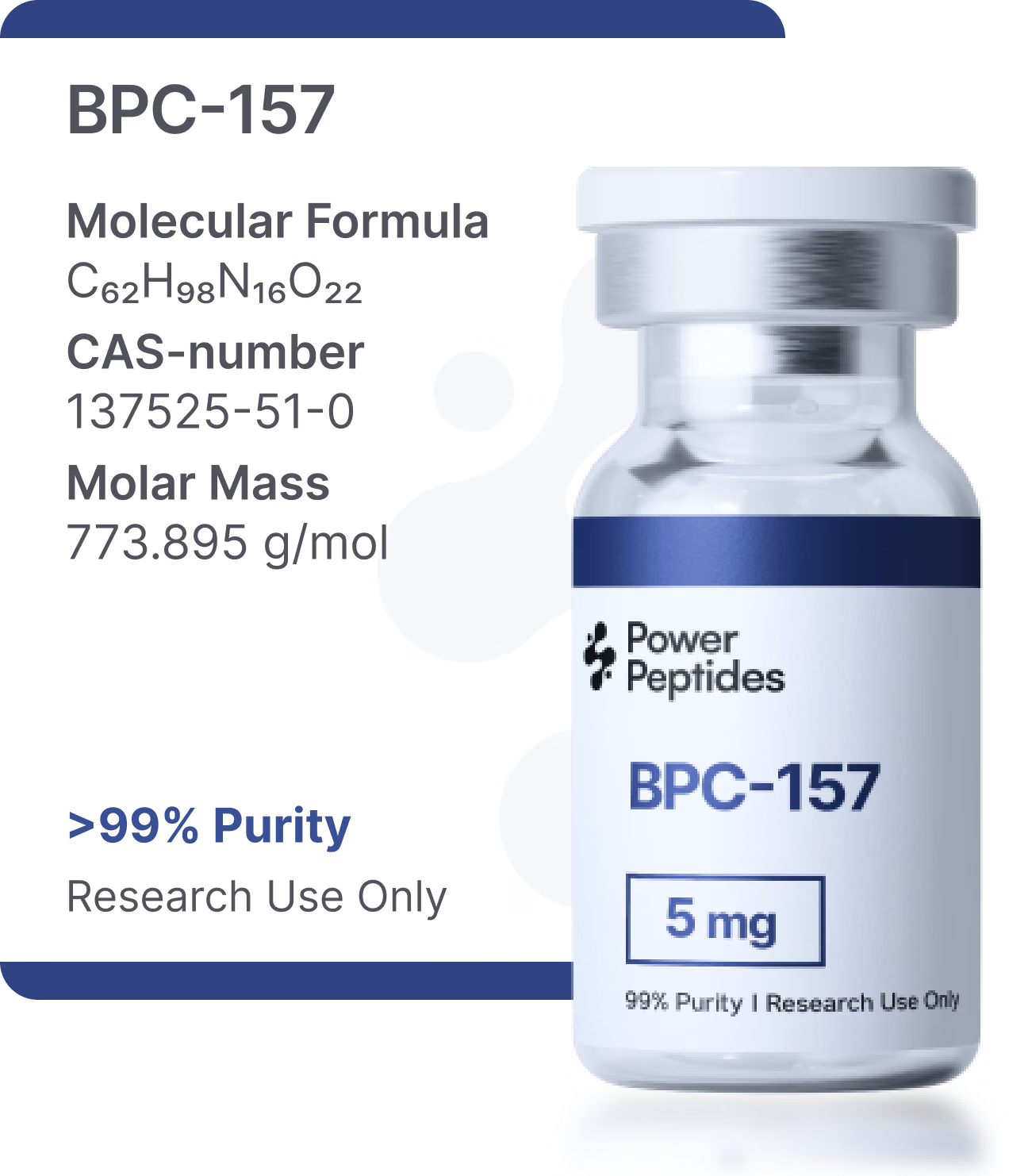BPC-157
- Buy 3+ for $51.29 each and save 5%
- Buy 5+ for $49.67 each and save 8%
- Buy 10+ for $48.59 each and save 10%
- Estimated Delivery : Up to 4 business days
- Free Shipping & Returns : On all orders over $200
Characteristics
|
Molecular Formula |
C62H98N16O22 |
|
CAS |
137525-51-0 |
|
Molar Mass |
773.895 g/mol |
|
Amino Acid Sequence |
GVSWGLR |
|
Synonyms |
Bpc-157, 137525-51-0, Bpc 157, Bepecin Bpc 15, Bpc157, Body protection compound 15 |
|
Solubility |
Soluble in Water |
|
Organoleptic Profile |
White powder |
|
Composition |
Lyophilized powder – requires reconstitution |
How does BPC-157 work?
BPC-157 is believed to work through several mechanisms to support healing and tissue regeneration. One of its primary actions is promoting angiogenesis, the formation of new blood vessels. This increased blood flow can help deliver oxygen and nutrients to damaged tissues, facilitating repair and regeneration. BPC-157 has also been shown to stimulate the production of collagen, a key protein in connective tissues such as tendons and ligaments.
Additionally, BPC-157 may have anti-inflammatory properties, helping to reduce inflammation and oxidative stress in various tissues. This can create a more favorable environment for healing and may help alleviate pain associated with injuries or inflammatory conditions.
BPC-157 has also demonstrated neuroprotective effects, potentially helping to protect and regenerate nerve cells. This may be beneficial in conditions involving nerve damage or degeneration.
Furthermore, BPC-157 has been shown to interact with the nitric oxide (NO) system, which plays a role in various physiological processes, including blood vessel dilation and tissue repair. By modulating the NO system, BPC-157 may help regulate blood flow and support healing processes.
While the exact mechanisms of action are still being researched, BPC-157’s potential to promote angiogenesis, collagen production, and tissue regeneration, along with its anti-inflammatory and neuroprotective properties, may contribute to its therapeutic potential.
Benefits
-
BPC-157 has been studied for its potential benefits in various health conditions. It may help accelerate wound healing, promote tissue regeneration, and support the repair of tendons, ligaments, and muscles. BPC-157 has shown promise in the treatment of inflammatory bowel disease, potentially reducing inflammation and promoting healing in the gut.
-
In animal studies, BPC-157 has demonstrated potential benefits in treating joint and tendon injuries, such as tendinitis and osteoarthritis. It may also have neuroprotective properties, which could be beneficial in conditions involving nerve damage or degeneration.
-
Additionally, BPC-157’s potential anti-inflammatory and antioxidant effects may help reduce oxidative stress and inflammation in various tissues, supporting overall health and recovery from injuries or chronic conditions.
Side Effects
In animal studies, BPC-157 has been well-tolerated with no reported severe side effects. However, as with any substance, individual responses may vary. More research is needed to fully understand the potential side effects of BPC-157 in mammals, including long-term safety.
Summary
BPC-157 is a promising synthetic peptide derived from a protein found in gastric juice. Research has shown its potential to support healing processes, promote tissue regeneration, and reduce inflammation in various tissues. BPC-157 may work by stimulating angiogenesis, collagen production, and modulating the nitric oxide system. It has been studied for its potential benefits in treating conditions such as inflammatory bowel disease, joint and tendon injuries, and skin wounds. Additionally, BPC-157 has demonstrated neuroprotective properties and may help reduce oxidative stress. While more research is needed to fully understand its mechanisms of action and long-term safety in mammals, BPC-157 continues to be a subject of interest for its potential therapeutic applications.
Certificate of Analysis (COA)
References
| Size | 5mg |
|---|

Reviews
There are no reviews yet.